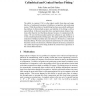Free Online Productivity Tools
i2Speak
i2Symbol
i2OCR
iTex2Img
iWeb2Print
iWeb2Shot
i2Type
iPdf2Split
iPdf2Merge
i2Bopomofo
i2Arabic
i2Style
i2Image
i2PDF
iLatex2Rtf
Sci2ools
BMVC
2001
2001
A Buyer's Guide to Euclidean Elliptical Cylindrical and Conical Surface Fitting
The ability to construct CAD or other object models from edge and range data has a fundamental meaning in building a recognition and positioning system. While the problem of model fitting has been successfully addressed, the problem of efficient high accuracy and stability of the fitting is still an open problem. In the past researchers have used approximate distance functions rather than the real Euclidean distance because of computational efficiency. We now feel that machine speeds are sufficient to ask whether it is worth considering Euclidean fitting again. This paper address the problem of estimation of elliptical cylinder and cone surfaces to 3D data by a constrained Euclidean fitting. We study and compare the performance of various distance functions in terms of correctness, robustness and pose invariance, and present our results improving known fitting methods by closed form expressions of the real Euclidean distance. 1 Motivation Shape analysis of objects is a key pro...
| Added | 30 Sep 2010 |
| Updated | 30 Sep 2010 |
| Type | Conference |
| Year | 2001 |
| Where | BMVC |
| Authors | Petko Faber, Robert B. Fisher |
Comments (0)

